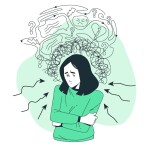The way we see others and make decisions about them often seems intuitive and immediate. How much of this is shaped by biases we might not even recognize? One of the most influential biases in psychology is the Halo Effect. Coined by psychologist Edward Thorndike in the early 20th century, the Halo Effect reveals how our overall impression of a person, product, or entity can significantly influence our judgments about their other attributes, even in areas unrelated to the first judgment.
Why do we love actors? Because of HALO effect
Have you noticed most of the times we don’t really know the celebrities we follow? We don’t love them for who they are but for the character they portray. We fall in love with the characters and not the people playing the character. But for us, it doesn’t matter. Why?
There’s a psychological phenomenon called Halo effect
Where our overall impression of a person influences how we feel and think about their character and abilities. Essentially, if we see someone in a positive light, we're more likely to overlook their flaws and attribute positive qualities to them, sometimes without sufficient evidence.
You being irrational in your choice of favourite Instagram celebrities is one thing – but have you ever considered how this impacts job interviews?
Studies suggest applicants from the same schools, same cities, same backgrounds are 36% more likely to get hired than the rest. The Halo effect is a bias which can lead us to make unsupported judgments about someone based on a general impression, which might not be accurate.
What is the Halo Effect?
The Halo Effect refers to a cognitive bias where an observer's impression of a person or thing in one area influences their judgment in other, unrelated areas. Thorndike's initial studies demonstrated that military superiors often rated their subordinates' physical attributes—such as neatness and physique—as directly correlated with unrelated qualities like intelligence and leadership ability. This bias distorts our perceptions and often leads to inaccurate evaluations.
For instance, if someone is beautiful in the physical sense, we will tend to attribute positive qualities such as a good heart or smart to them, even if we don't have any proof for that. This is an archetypal illustration of the Halo Effect.
The Halo Effect dominates in everyday life in how we form perceptions in most walks of life. Here are a few examples:
1. Personal Relationships
In personal relationships, the Halo Effect can distort the way we interpret someone's behavior. For example, if a friend or partner is generally warm and caring, we might excuse occasional lapses in their behavior as anomalies. Conversely, a single negative trait in someone else might overshadow all their positive qualities.
2. Workplaces
In professional settings, the Halo Effect often influences hiring decisions and performance evaluations. An employee who dresses sharp and exudes confidence can be perceived as more competent. This can lead to a lot of favoritism, inequities in promotions, and poor organizational decisions.
3. Marketing and Branding
The Halo Effect is a strong marketing tool. Companies use it with celebrity endorsements, assuming that the consumer's adoration for the celebrity will spill over to their products. For instance, if an athlete promotes a sports drink, we might associate the drink with high performance and health without even knowing why.
4. Education
Teachers may unknowingly fall victim to the Halo Effect by allowing a well-mannered student or a student's handsome appearance to influence how to grade the student's academic ability. A well-behaved student may receive high grades, while an awkward one may be labeled poor.
5. Health-care
In healthcare settings, the Halo Effect can impact doctor-patient interactions. A doctor’s likable demeanor might lead patients to overlook potential errors or misdiagnoses, while an aloof doctor might be unfairly judged as less competent.
Impact of the Halo Effect
The Halo Effect extends far beyond everyday interactions, shaping societal norms and institutional practices. Let’s explore its broader impacts:
1. On Hiring Decisions and Performance Evaluations
The Halo Effect can lead to biased hiring practices. Candidates with charismatic personalities or impressive appearances might be favored over more qualified individuals. Similarly, in performance reviews, managers may overlook an employee's shortcomings if they excel in one particular area.
2. In Education Systems
Teachers' biases, influenced by the Halo Effect, can have a bearing on students' academic paths. This perpetuates stereotypes and creates unequal opportunities for students based on factors like socioeconomic background, race, or gender.
3. In Legal Judgments
Jurors and judges may be influenced by the Halo Effect, consciously or unconsciously. For example, an attractive defendant may receive a lighter sentence than someone who is perceived to be less attractive, although the evidence is similar.
4. In Media and Pop Culture
Media perception of people often depends on the Halo Effect. Politicians, celebrities, and influencers are often based on their public image so that their actions or competency can be overshadowed in a way.
Why we fall for the Halo Effect
The Halo Effect has cognitive shortcuts that help fasten information into our brains quickly. There is always heuristics. These help manage the deluge of stimuli we face, but usually, they impair accuracy.
1. How the Halo Effect Works Like a Ruse
First impressions are lasting and powerful. Studies have proven that we tend to form judgments about people within seconds of meeting them, using appearance, tone of voice, and other surface-level characteristics to make our judgments. These first impressions then influence our subsequent judgments.
2. The Role of Cognitive Dissonance
When our judgments conflict with some of our existing beliefs or feelings, it creates discomfort known as cognitive dissonance. We are likely to unconsciously strengthen the initial impression, even when it is wrong.
3. Emotional Connections
Halo Effect is emotionally biased. Positive feelings towards some one or something can create subjective thinking, which would limit our ability to think objective about other characteristics.
How To Overcome Halo Effect
Self-awareness and conscious effort are necessary to recognize and mitigate the Halo Effect. Here are some strategies:
1. Critical Thinking
Challenge your first impressions: Are they based on objective facts or subjective feelings?
Seek evidence to support your judgments rather than assumptions.
2. Structured Decision-Making
Use rubrics and standardized criteria for evaluations, whether in hiring, grading, or assessing performance.
Encourage multiple perspectives to reduce individual biases.
3. Mindfulness Practice
Stay present and avoid jumping to conclusions.
Pay attention to how your emotions might be influencing your decisions.
4. Encourage Feedback
Seek feedback from others to identify and address potential biases in your judgment.
Create an environment where constructive criticism is welcomed and valued.
Applications in Therapy and Counseling
The Halo Effect is not just a bias to counteract but also a concept that can be utilized constructively in therapy and counseling settings. Here’s how:
1. Becoming Aware of Biases in the Client-Counselor Relationship
A good first impression can create overly optimistic impressions about a client's progress, and bad ones can create obstacles for empathetic support.
2. Assisting Clients to Uncover Assumptions
Clients often base decisions on assumptions that are not under their control, based on the Halo Effect. The counselor helps them to identify such biases and asks for critical reflection in forming balanced judgments.
3. Building Favorable Associations
The Halo Effect can be used positively to strengthen good habits and behaviors. For example, associating a healthy lifestyle with personal strengths can motivate clients toward positive change.
Conclusion
The Halo Effect is one of the most universal and influential psychological effects on our perception and decision-making, largely unconscious to most people. By recognizing the mechanisms and impacts behind the Halo Effect, one can make better, fairer decisions by taking mitigative actions against its destructive potential. From personal and family relations to professional lives or the greater society, acknowledgment of the Halo Effect serves as an important step toward more self-knowledge and justice.
The ultimate is mind and critical thinking. Instead of judging based on first impressions, we can have deeper and more precise understandings of people and situations. The Halo Effect reminds us that human judgment is complex and calls us to strive for balance as we perceive and interact with the world.








